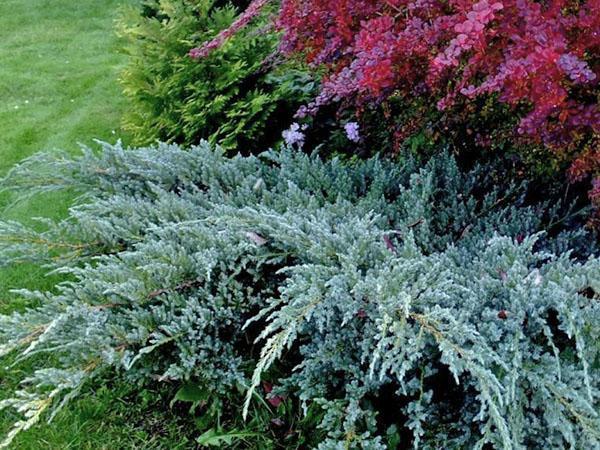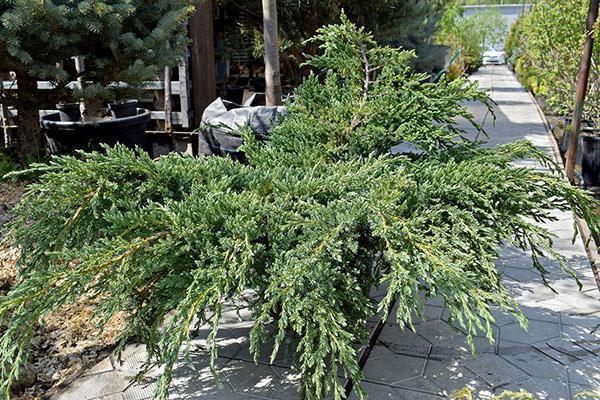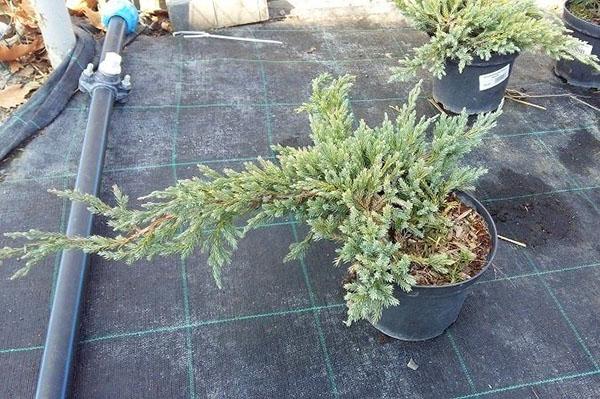We choose the scaly juniper Blue Carpet for the design of our site
 Juniper Blue Carpet is an evergreen coniferous shrub. It is characterized by a flat, highly branched crown. The variety got its name for its silvery-blue needles. Under favorable growing conditions, it can tie dark blue berries. Read about horizontal juniper!
Juniper Blue Carpet is an evergreen coniferous shrub. It is characterized by a flat, highly branched crown. The variety got its name for its silvery-blue needles. Under favorable growing conditions, it can tie dark blue berries. Read about horizontal juniper!
Varietal characteristics

- bush height 30-40 cm;
- width up to 1.5 meters;
- life expectancy over 200 years.
Juniper juice has toxic properties, so it is best to carry out all care work with rubberized gloves.
The main value of the Blue Carpet variety is its unpretentiousness and fast growth.
Planting and leaving
 Planting and caring for the Blue Carpet juniper is not particularly difficult. The plot for its cultivation must meet the following requirements:
Planting and caring for the Blue Carpet juniper is not particularly difficult. The plot for its cultivation must meet the following requirements:
- High level of illumination.
- Lack of closely spaced groundwater.
- Non-saline soil.
The best time to plant Blue Carpet juniper in a permanent place is spring or early autumn. The size of the planting pit depends on the size of the acquired seedling. On wet soils at the bottom of the planting pit, drainage from a layer of rubble or broken brick must be arranged. After the end of planting work, it is advisable to mulch the near-stem circle of the plant with a layer of peat.
 After planting, care for the scaly juniper Blue Carpet consists in a systematic watering... Adult specimens are usually more drought tolerant than young ones, so they are watered only during severe drought.
After planting, care for the scaly juniper Blue Carpet consists in a systematic watering... Adult specimens are usually more drought tolerant than young ones, so they are watered only during severe drought.
Juniper responds very well to evening spraying of the crown with cool water.
Also, do not forget about the removal of weeds. To reduce the number of weeding, the trunk circle is covered with a layer mulch from pine bark, chips or gravel. Every spring, junipers are fertilized with a special fertilizer for conifers. In its absence, you can also use a nitroammophos.
 The Blue Carpet Juniper can sometimes suffer from the rays of the bright spring sun. To protect the plant from sunburn, its crown is covered with a white non-woven covering material or a special green mesh since autumn. It does not require additional protection from winter cold. In most regions, it tolerates even the harshest winters.
The Blue Carpet Juniper can sometimes suffer from the rays of the bright spring sun. To protect the plant from sunburn, its crown is covered with a white non-woven covering material or a special green mesh since autumn. It does not require additional protection from winter cold. In most regions, it tolerates even the harshest winters.
The Blue Carpet variety does not need formative pruning. Exceptions are cases when diseased or dry branches appear on the plant. When growing a juniper next to deciduous plants, when preparing it for wintering, care must be taken to ensure that no deciduous litter remains in its crown. In the process of decay, it can damage the branches or even cause partial withering of the bush.
Photo of Blue Carpet juniper in landscape design
 Photo of the Blue Carpet juniper can often be found on specialized resources dedicated to landscape design... It is a fairly popular, affordable and unpretentious plant. It can be used in a wide variety of garden compositions.
Photo of the Blue Carpet juniper can often be found on specialized resources dedicated to landscape design... It is a fairly popular, affordable and unpretentious plant. It can be used in a wide variety of garden compositions.
Very often from the Blue Carpet they create spectacular single groups against the backdrop of the lawn. The only drawback of such compositions is the inconvenience of mowing the lawn around them. It is much more convenient to include junipers in other groups of conifers. For example, a creeping Blue Carpet can be planted in the foreground with taller varieties of junipers in the back.
It is much more convenient to include junipers in other groups of conifers. For example, a creeping Blue Carpet can be planted in the foreground with taller varieties of junipers in the back.
You can also create more complex compositions using other conifers, deciduous shrubs and herbaceous perennials... Blooming annuals also look good against the background of juniper. When creating such groups, the most important thing is to maintain the correct distance between the plants so that they can fully develop without overwhelming each other.
 Thanks to its creeping shape, the Blue Carpet can be used for decorating slopes and also as a ground cover plant. It is also suitable for growing on an alpine slide or in a flat rockery. You can even decorate the shore of a garden pond with this juniper.
Thanks to its creeping shape, the Blue Carpet can be used for decorating slopes and also as a ground cover plant. It is also suitable for growing on an alpine slide or in a flat rockery. You can even decorate the shore of a garden pond with this juniper.
 Blue Carpet goes especially well with the following plants:
Blue Carpet goes especially well with the following plants:
- roses;
- garden geraniums;
- spring bulbous;
- herbaceous ground covers.
 It is irreplaceable in urban landscaping. This variety is highly resistant to polluted city air and lends itself well to artistic shaping. It can even be used as a container crop if needed.
It is irreplaceable in urban landscaping. This variety is highly resistant to polluted city air and lends itself well to artistic shaping. It can even be used as a container crop if needed.